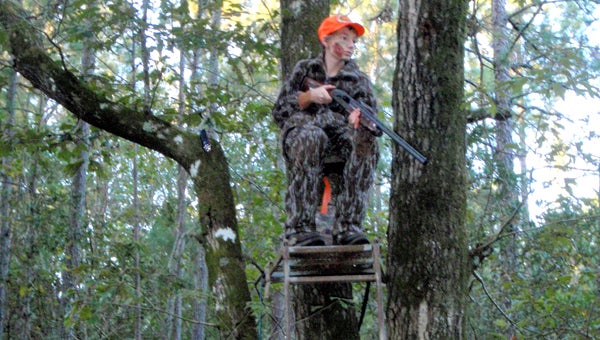Hunting from elevated deer stands can be dangerous
Published 12:44 pm Saturday, September 26, 2015

FRED BONNER | CONTRIBUTED
BE CAUTIOUS: This young deer hunter is prepared to shoot his first deer while shooting from an elevated stand. Hunting from a stand such as this without having the proper safety measures in place is probably the most hazardous kind of hunting an outdoorsman can participate in.
It seems like every year, just before the regular gun season for whitetail deer opens, every hunter sees (and hears) warnings about tree stand safety. In spite of these warnings, there are always a few deer hunters who climb into their elevated stands and ignore the well-intentioned warnings.
No one is more concerned about tree stand safety than our own North Carolina Wildlife Resources Commission (NCWRC). Their excellent hunter safety program teaches this important part of safely hunting as a vital part of their training and every year someone ignores these words of wisdom and takes a spill from their deer stand.
Several years ago, the NCWRC’s pre-deer season missive stated, “More people are hurt falling from tree stands than any other type of hunting accidents, yet tree stand-related injuries are almost always avoidable.”
As usual, a number of deer hunters didn’t take heed of these warnings and during the 2012 deer season, officers with the NCWRC investigated two fatalities and seven injuries that were related to tree stand use.
It’s difficult to approach your deer stand in the pre-dawn hours, take time to strap yourself into a good safety harness, secure your unloaded gun to a cord, make sure your gear is securely attached to said cord and then begin to quietly climb your way into the elevated structure that you’ll call home for the next few hours. Stealth is essential to many successful deer hunts and to properly prepare all this safety equipment takes time, usually making enough noise to alert any deer within hearing range that a hunter awaits up in that tree.
Learning to quietly take the proper safety precautions before climbing that tree is far more important when one compares the cost of a nice buck to the possibility of taking a spill from up in the stand, being paralyzed from the waist down or facing a lifetime of being physically impaired.
I’ve known several deer hunters who have had the falling-from-a-tree-stand experience and they’ve told me that, “It just ain’t worth the chance to ignore these safety rules.”
“Following some basic guidelines can prevent most of these costly spills,” states the NCWRC’s hunter safety rules. First, “maintain three points of contact when climbing up or down. Secondly, use a full body safety harness at all times. Thirdly, check belts, chains and attachment cords before use and, finally, follow manufacturer’s instructions that should have been included with your manufactured tree stand.”
The NCWRC also recommends,“Never carry anything as you climb — use a haul line to raise and lower an unloaded gun or other equipment after you are seated safely in the tree stand.”
Many hunters even carry a waterproof container into their deer stand to be used for their human waste products during the hunt. A zip-lock plastic bag works, just be sure that the bag isn’t one of the ones that has small holes in it, like the ones you use to keep vegetables fresh. This type can make a mess.
Have an emergency signal, such as a cell phone set on vibrate, rather than having a noisy ring or other incoming call signals. A whistle or some other noisemaker to attract help should you be incapacitated after a fall is recommended as an emergency safety tool. The louder the call, the better.
Many deer hunters today carry a marine band VHF radio to communicate or summon help if they’re incapacitated. These radios are (by law) to be used by boaters on the water, but the U.S. Coast Guard has told me they can’t enforce the law if the violation doesn’t take place on the water.
Always let someone know where you plan to hunt and when you plan to return. Better yet, leave written instructions as to where you’ll be if you’re in need of help. Some really well prepared deer hunters even leave their stand’s GPS coordinates on their emergency instructions. This would be a tremendous aid for a rescue team on a dark night in the woods.
One experienced deer hunter recently told me about having spent a very, very long, and very uncomfortable night hanging by his back in a tree after his deer stand unexpectedly let go.
“I’d followed the safety rules and put on my safety harness as soon as I climbed into my stand and when the stand collapsed as I was getting ready to come down from the tree after dark, the harness kept me from falling a long way to the ground. The only trouble was that it left me hanging, high in the tree, with my back to the tree.
“I tried and tried to get turned around with my face to the tree to allow me to get down, but I couldn’t. I spent the long, cold night and the entire next morning hanging there there with my back against the tree.
“I didn’t have my whistle, cell phone or emergency flares because they were still in my pack up in the tree. It was early the next afternoon before the rescue team found me and I don’t think that I could have lasted much longer.
“They had to carry me out to the ambulance that was waiting on the road. They just happened to find me because I hadn’t left any instructions as to where I’d hung my stand the night before.”
Some lessons can be learned from his experience. Don’t use a harness that leaves you hanging by a connection that holds you with your back facing the tree and keep some kind of communication gear accessible and on your person.
Apparently this hunter’s older deer stand had some rusted joints and it was the weakening of the stand that caused its’ collapse as he tried to come out of the tree after dark. Always be sure all your gear is in A-1 condition. Your life may depend on it.





